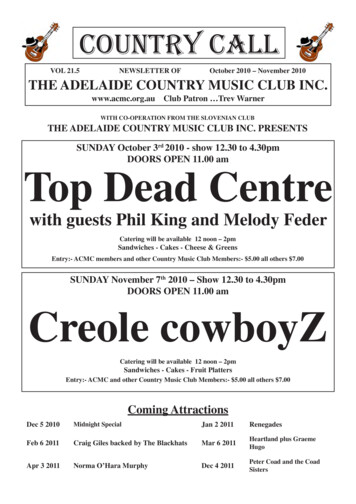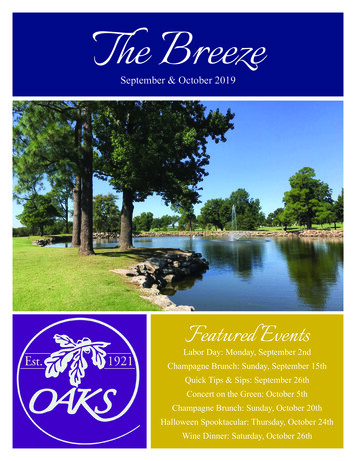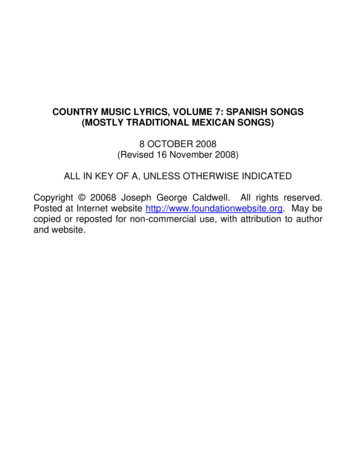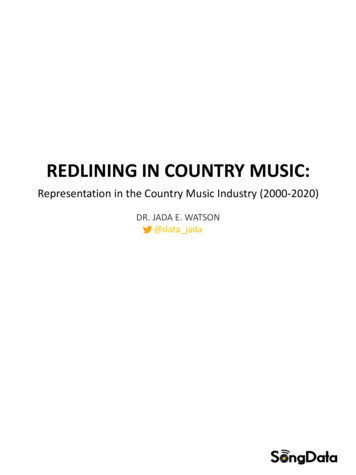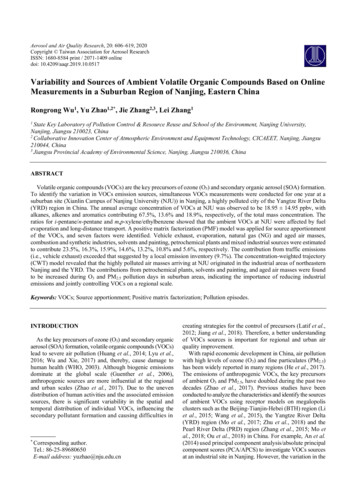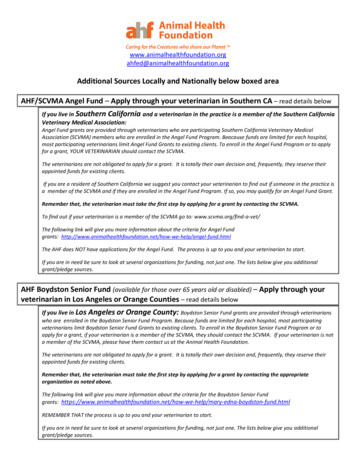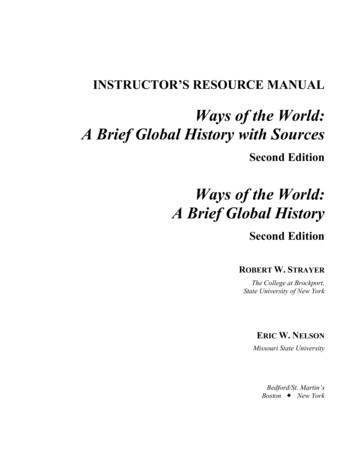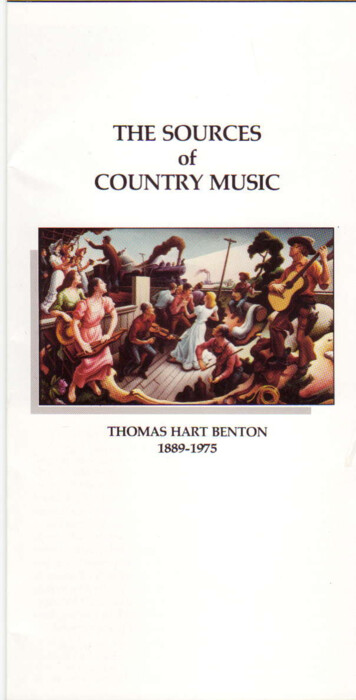
Transcription
THE SOURCESofCOUNTRY MUSICTHOMAS HART BENTON1AA9-1975
We at Smith Kramer are proud to b part of theeffort to celebrat th work of Thomas Hart Bentondudng the looth anniversary of his birth. "TheSourc s of Country Music" will be seen in manycommunities across the country thanks to thededication of the professionals who have workedwith us to make this proiect a reality.We are thankful, first and foremost, to theCountry Music Foundation of Nashville for sharingtheir murat and the 32 accompanying studies. Allworks inthe exhibitar partofth collections oftheCountry Music Hall of Fame and Museum. DianaJohnson and Chds Skinker of the Foundation havebeen unfailing in their behind-the-scenesefforts toinitiate this tour.H nry Adams, Curator of American Art at theNelson-Atkins Museum of Art, has off red continued assistanceand support. He has provided thee55ayon thesepage.The spon'oringenLertarninginstitutions who have o{fered their supPort byparticipating in th tour of the mural also deserveour thanks.The responses we receive from these sPonsorsand those who vi w the exhibit are very gratifying.We look forward to sharing this delightful andhistoric exhibit.David L. SmithSmith Kramer, Inc."The Souces of Country MusiC' mural
The Sourcesof Country MusicOn January r8ih of I975, in his .arriage-house studioin KansasCity, Thomas Hart Benion put the last brushstrokes on his painting Tl.50,rds o/ Cd!rtr! M,i,. Themural had be n .ommissioned the year before by Nashville's Couniry Music Foundation to be displayed in rheCounhy Music HalL of Fane and Museum. Its conpletion, in less than ; year, by an eighty-five ye.arold ariisi.was an impressive physical achievenent.The task might have erhausted a nuch youngerpainter, for thesix by ten f et andcontains seventcen nearly life sized figures. But TomBenion took on the project becausethc subje.t was ver!op rr'o h m lJ m . r nle- p .r i n , -Irry n u . h r-th d l .,l rman actively invdved wiih it, he was himself a giftedm u si ci a n,aswellas i c o l l e c to ro fA m e i i c a n fo l k tu n e s .InTh a So ,t N al Ct unt r , !M ,s i t h c d i s ti l l e d th e s tu d y a ndhrrd work of a lifetime"l remembef it from my childhood," Tom renarked ofcouniry music, shortl)' after he was commissioned tomake the Nashvillc nural. "l was raised down insouthwest Missouri, and the only music we had wascountry music. So I was preity familiar wiih ii. I wasramilia. with the songsand with agood deal oflitcratureTom's maternal grandfather, Pappy Wise, of Waxahachi , Texas, was a violin naker andused to set up ir the early hours ofthe noining and pl.\'counby fiddle tunes., His mother was a serious pianistDespite this exposufc to music, however, Tom did nortake up an instrument himself until 1931, when he w.rsrorty one years old. One day he picked up a child'sharmonica ihat someone had given to his son T.P. andbegan to make noiscs.Afiersome experiment, he learnedto play a scale and became so excited that he ran homefrom his siudio to show his new skill to his wif , Rita.Tu n e swer e t oo m uc hfo rh i m , h o w e v e r,s o h e w e n to utand purihased some music books. Ior weeks h didnothing but play children's sonAs and elementary folktunes. After his playing improved, he pur.hased a moree\p p n 'i ve l. r , m r ni, r t lrl a l o w e d l -rm to p .d y l -rl t--o t e.dn d m.,\p \ eyH p J n d R ,L db F g rn p l ry i -g the' hdr gF .guitar and harnonica togeiher in th evenings.For awhile Ton was more interested in ihe harmonicathan in painting. Thanks to his enthusiasm, a few of his1 .l n ttrir r bvhhn A \ nir l a ,ri .l i i n , T h e s o u rc e os fC o u n irvMu \ ,.J c .l2. Araflling tD hi\ \i\Jrt Mi ttlIttlhs thtt Prtv \t\ia h l nrd1Snqll, fott@rttoN rl th,
students be.ame interested as well and began meetin8 athis home on Monday eveninss for musicales.To make it easier for the novice, Ton devised a newform ofmusical notation, which was later picked up, andis still used by comm rcial music publishers-Raiherthanindicating the position of a note on the scale,thb systemindicat d numedcally whi.h hole to blow throush, andhad an !p or down arow indi.ating wheth r to inhale orFor five years, playing the harmonica occupied muchof Tom's time. He began taking it wiih him on hissummertravels and would perforrn in farmhousesand atcountry dances.As his ear improved, he besan colle.tingAmerican folk tunes. Helen Lieban, who visited Tom inMusic, next to paintinS dominates the Benbn menage. Mrs- Benton sings the sonAs of her native Lombardy to her own guitar accompaniment,while Bentonpuffs lusiil)' on his harmonica, showina spe.ial partiality for such early American folk tunes as "Old JoeClark," "My Horses Ain't Hungry," and "Buf{aloGals." Of later years he has gone in relentlessly forBeethoven,Bach, and MozarL makinS up in fire whath lacks in virtuosity.sDuring the r93o's, Benton sketched and befriendedcountry fiddlels like Uncle Lavrrenceand Dudl y Vance3. Hd?n Litbin, Thand. Bolon, Anttittt)esign,D.dml'rr, I'r3,1r' J.lMtttL Pnirttt,
(both of whon are mentioned in A, Altist ifl Ahtkn,Tom's colorful autobiography); made po raits of modern composers su.h as Edgar Var se and Carl Russles,and befriended the musicologist Charles Seeser,an early.ollecior of American folk songs. Charles Seeg r'sson,the folk singer PeteSe serhasrecalledthat he firstheardthe sons "lohn Henry" when B nton performed it forMany of Benion's best pajntings of the 1930's lrantirrnd lahnv, Thel.olDu' Lott of theLaneGreenv ollry, and TheEngin*r's Drean, for example-w re directly inspir d byfolk songs. In ihe mural panels he created for iheWhiiney Museum in New York in 1e32,Tom included alikeness ot Wilbur Levelett, from Calena, Missouri,playins the guita' Dudley Vance, from BlulT City,Tennessee, playing the liddle; ud his pupil JacksonPollock playins the harmonica.Indeed, Benton probably tried to create visual styleswhich corr lated with the various types of music that hetoyed. The k lon La"o ol Latu Cfter v llev, fot example,evokes the sadness of a countiy fiddle tune; whereasIotreion?Road,a likeness of a black man with a mure anoa ramshackle cart, has the serio.omic mood and thejerky, unexpected rhythms of the blues.In 1941 Bentd even flirted with a career as a harmonica virtuoso. In thai year h cut a three record album,releasedby Decca, titled "Saturday Nisht ai Ton B ntont" (Decca 331). In it he tooted out tunes on his
Upper body, headdulcine. playerharnonica, backed by an orchestraotproFesrional musiAs a consequ nceofhis nusi.al interesis,Tom Bentondid n o t n e ed m uc h per su a d i n g w h e n h e w a s fi rs tapproached by the Country Music Foundaiion. In January, 1973, when Nornan Worlell, direcior of theTennesseeArts Comnission, and Tex Ritter, ihe famed.owboy sing r, visiied him in KansasCity, Tom warmedup almosi immediately to Tex's suSgestionthat he createof th e r.o L . o f L o u .l ry mu \i ,a larg e vr-u al' um m a. yWhile he and Ter sipped Jack Daniels together, Tomrepeated, "The sources oF country music-thatt it." Hethen elaborated: "No one should be recosnizable. Itshould show the roots of the music th sources-beforether were records and stars."aBenton laier commenied:I'd had considerabLeinterest in folk music of theUnited States in various times in my life. So I didn'thave to do any research-l knew all ihai stuff. Th problem was merely to get it iogether, in my ownnind, about how I.ould represent these things in theNow a great deal of this folk sons orisinally camefrom the countries where ihe early settlers came from,4. Knnl Ann Malii,& Tom Berton and His Drawings.pdb tt i,Wli' i4\/ba".! - . . l u d ltUn .'.r'-, t r'P/' d r !f h c s o u t , " - o - ( oJF l' )M u ' !.l h eMa 'ngof'1975 lenpasinarartntt! MtstFo"ndttion, NaslrilkTo,*rfr,
a n d i n our own ihe mo s t o f' e m a re En g l i s h a n dScoich lrish, but they, naturally, were modified in theAmerican environment and took on iheir particularcharact r and their particular conient.Now this is an inierestina ihinA aboui .ountrymusic. Until very Latelythey used no percussion, note ve na b anjoor as uit a r. E v e ry th i n sw a s e i th e rfi d d l eorsinSing.The singing was sometimes part sinaing iwoand three, generally three parts; but there was no kindof percussion instrument, say iike a banjo, which hassome ofthe attack that a percussioninstrumeni wouldhave. They were not used. I don't remember anyguitar playing in my youth in the Ozalk country at all,in my early youth. The only banjos that were everplayed were ihose in the old minsirel shows.sBenton beAan planning the Nashville painting in ihefall of 1973. In December he wrote to William Ivey,executive director of the Country Music Foundation,ursing that "people should express their opinions andpreferences,?'and suggesting that the painting mightinclude "pioneer liddlers and square or play partydancers hvmn singers,(white spiiituals)-ballad singers(rnaybewiih dulcime.), blues sins rs-(nesro with banjo,mJyb eo n t hebelo B M e m p h i .) C o w b o y ,i n 8 " h v er first ofetc., etc."6 By' rtheJanuary 1974, Benton hadsubmitted an initial sketch to the Board of the tounda5. l, nrf ir Db i r , j ! / i t r , , 1 l hn itr:,4 a\-)'1.4 ,"
"Thc Sourc sof Count.y Mnsic"5e ve ra L . r lhcf s c s c c nc sw c rc c l o s e l vre l .te d b l o m ' se. r .l i e .p a nr t ings! nd pdn i s . F o r c x a mp l ., i h c g fo u p o ldnn .e rs b .ings t u m ind an i l L u s i ra i i o nh e ma d e h 1 s s 4f of th e p l .r! ( ; n?, ( ; r . r . r J ! .1 rl ,r.r( ro mN h i c h th e mu s i c a lOlhl ,,!"i rwr s der ir ed) . rh e c h u rc h c o mc s ri s h t o u t o fihc,4 ,/r i ' l r l, t S , ' r r I p. ] n e l o f 1 9 3 2 fo r th e l \h i h re v\ 4J . n ., J . . , pp. . , - pJl i p , n h ,. ro r- , r ' \J , , ,ln L i te l inu. r v , ilhc n th c b o .fd m c t to d i s a u s sth eske t.h ,th ey un. lnim ous lyv o i e d to d e d i .a tci h c mu ri l 1 oT cx R i tte r ,who had died j u s i a s h o ri i l h i l e b e fo re .T h e ynlso m.d c a nunber of s u g g e s i n h s . T h e v fe l t th a tBento n ! sk et . h em phas iz e dtfe s q u i re d a n c et.rd l ti o n II it t le i o o muc h and not e d th a t i t l e ft o u t th e rrl n -i nimportant thcme in country music.On linu.rv 28, 1s7,1,Bcnton fcpiied to a letter ifomBill l ve !. "l go f or t he idea i h a t i h e m u ra l s h o u l dh s o m ewav bc a tribute to Ter Riite. Why don't we symbolizeTex i n l hc.ow bol si nge.?" H e,rl so foted, " l sr eat lythafk w hocv.r bro!8hi up the si g.i fi (rn.e or t herri Lnud trai n for ol r subj c.l . l l ow .!l dI heve or erl ooked i t? Though i i rtc thcm. I ngrc. that ,t , s boi nportht b rgnorc" 'ln febru.rry, BenkD leli on a thrcc !!cck "saihrg inuntnbort the E rham!s." A fi er hi s rctun, how cv.r, h c scl t ow ork fcvi si nghi s desi gn,.,ndi ,r Mrrch 1974he subm r tted i revi scd sket.h for the bor.d k).onsi de. I . t hisdi tw i nE he cLi mi natcdthe mol di i gs nr the e.rrl i ersket chand pi acedal l i hc fi sufc5 i n a uni fi edpi ctorl tl sp ace.Hercpl acedthecow boy on horscbackw i th a fathergener ali zcd portrai tof Tex R i i tef, .nd addcd i trai n, to suggestthc i mportrnceof rai l rodds.D gs.In addi i i on,on his own: rrf! .,r.rr l t. .r,rni rr rl i i 7.4 f,ri rt!11l i r i l or f , : r , irj i r i , rn!tr: ri r'.rfrl tr! 1rr,i ,n, .!i ,i ,,r! ()4f ,1 ri,: i i )r,:lj !,rrr!:'l ) Jrtrr; trB fl s93 !,[d i rr r,,s rrrf !r,n Jr;,h.ra ii . ,'r!rrf. i ri i {rr'h,,/,n fi tri r,, l )Ll ,10"r{
inspiration, he put in a steamboatto suBaestthe sianificanceof vermusic. The finaldesiSn contained 5cenesofa riverboat, a train, chuich singins, bam danonr, a blackbanjo pLayerand a singing cowbov.The Board of the Country Music Foundahon enthusiastically approved his r vised con.eption, and oler thesummer Benton worked on enlarging and Perfectina it.As was his custom, he made elaborate studies befolebesinnins work on the final canlas He .onslrucied apainted plasiicinemodel of the whole.omposition, madeoil studies in both back-and-white &d color. and drewcaretul pencil studies of the insirunents and each of theOver the summer h worked from models close athand, usins his daughter iesrie's friends and otheracquaintances.Benion was not tatisfied, hor{erer, with apainting based only on friends and professionalmodels.Eagerio capture the autheniic spint of count.\'music, hewent out to the Ozarks to lo ate som eu 'i!in8.ountrym u si ci a n s . ' 1 gues sI c o u l d u s th e fa c e o f a n a c to r,"Benton commented, "but sometimes rrhat People do forshows ina long time in iheir life-their o.dpationttheir faces. Or is suggested. That miaht be true in amusician- The emotions he has experiencednight 5how.I don't know. I just have to see the face."!ln the course of a few days, Benton did a number ofportrait studies, each about three inches squrre, whichiook about twentyminutes apieceto complete. Afterhalfa day ofsearchin8, Tom located Ravmond Bruffet, a localfiddler, who lived in a cabin deep in the rloods, surrounded by a dozen or so junked cats. He also hunteddown old Nick Nickens, a left-handed fiddler, and ChickAllen, whose instrument was the iatlbone of the mule(Allen would hang the dried bone around hi, neck on athong and rap it with sticks). A young woman at theSchool of ihe Ozarks posed w'th her morth open, as ifsinging. Benion laier drew on his sketch of her forseveralnembers of the church choirTom rlas equally careful about the insttuments, costumes, and background details of the paintina.On e o f t he el" m ent . w h ,c h c ,u .e d h i m mo ' i tu n c e ' nwas ihe train. The image of a train appenrs in countrymusic in many vtell known sonss,such as "The Wreck ofThe Old e7," "The Wabash Cannonball," and "CaseyJones."Benton was particularLycon ernedthat th trainbe reprerented a.urately. H decided ro use as hismodel Engine No. 382, th 'Cannonball Express," thetrain in which CaseyJonesperished in his famous wreck,a fasi
guitar playing in my youth in the Ozalk country at all, in my early youth. The only banjos that were ever played were ihose in the old minsirel shows.s Benton beAan planning the Nashville painting in ihe fall of 1973. In December he wrote to William Ivey, executive director of the Country Music Foundation,
